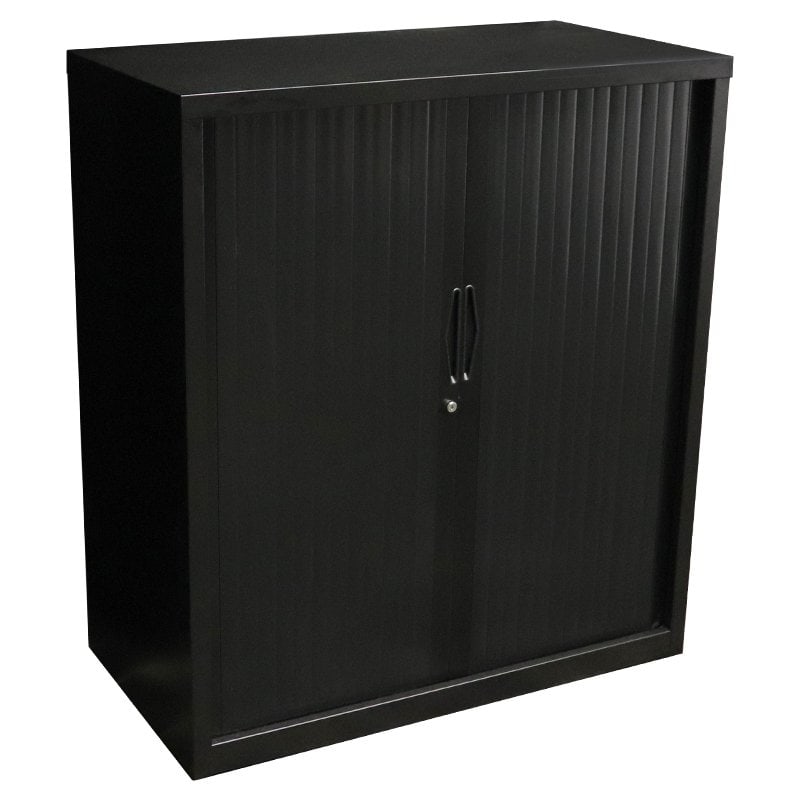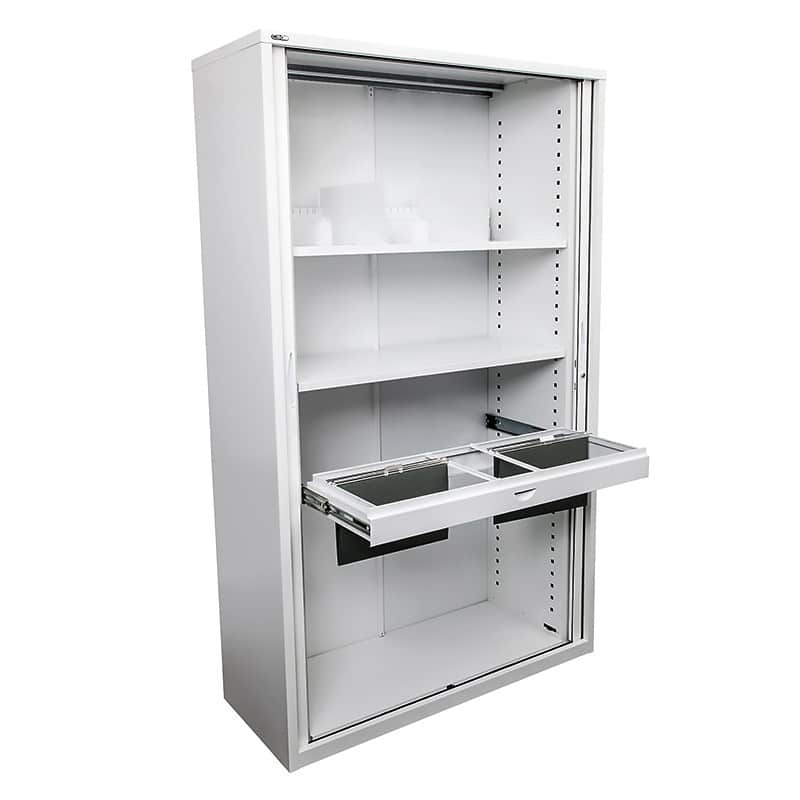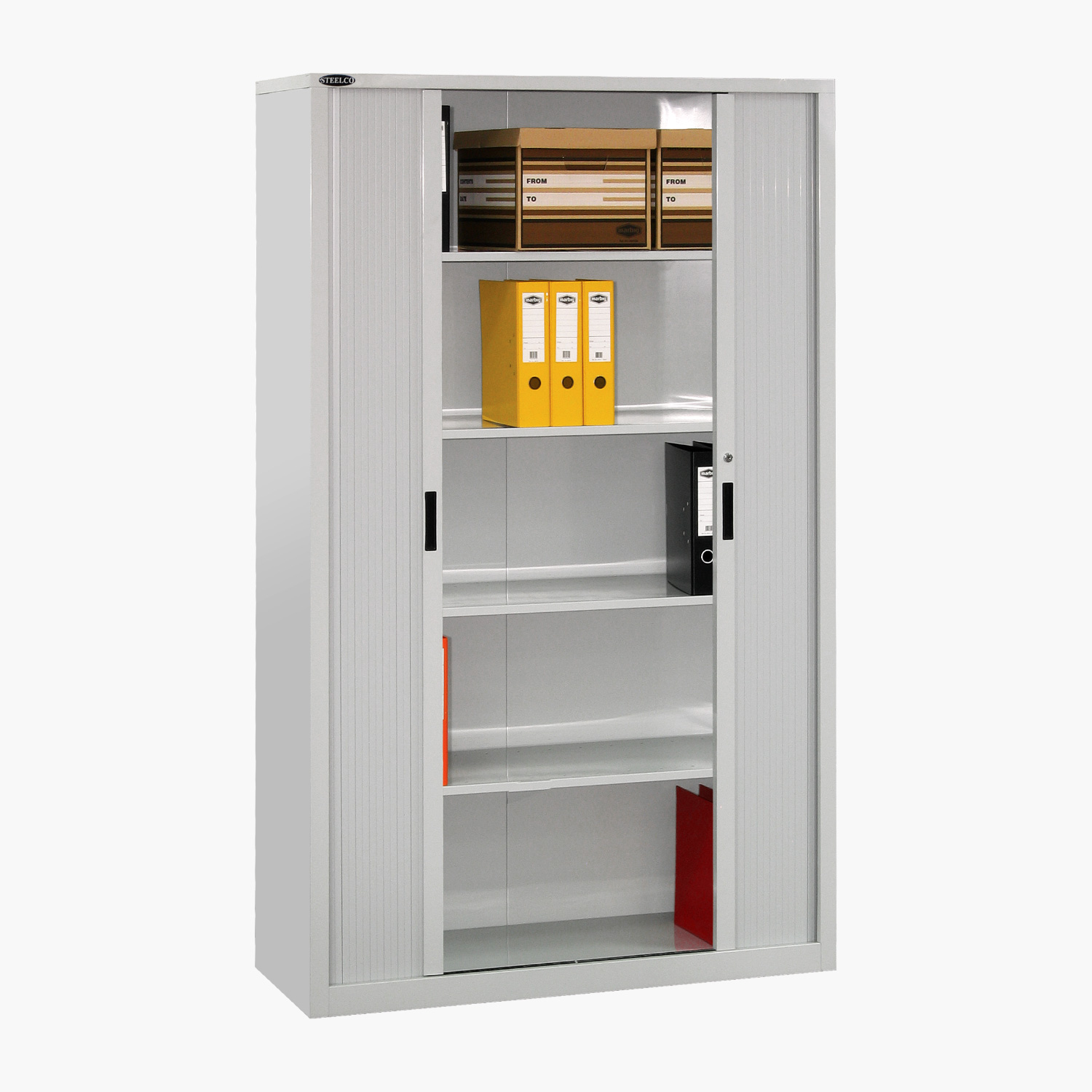Tambour Door Storage Cabinet

Tambour door storage cabinets offer a unique blend of functionality and aesthetics, making them a popular choice for various applications. These cabinets stand out with their distinctive sliding doors, which provide a space-saving and stylish alternative to traditional hinged doors. This article delves into the design aspects of tambour door storage cabinets, exploring their history, materials, mechanism, and benefits.
Tambour Door Technology: A Historical Perspective
Tambour doors, with their origins dating back to the 18th century, have a rich history in furniture design. Initially used for small storage compartments, their application expanded over time, evolving from simple wooden slats to more complex, sophisticated designs. The term “tambour” itself is derived from the French word “tambour,” meaning “drum,” a reference to the cylindrical shape of the sliding panels. Early tambour doors were primarily constructed from wood, but advancements in material science and manufacturing techniques have introduced a wider range of materials, including metal, plastic, and composite materials.
Tambour Door Storage Cabinet Applications and Uses

Tambour door storage cabinets offer a versatile and efficient storage solution for a wide range of applications. Their unique design, featuring a horizontally sliding shutter, provides space-saving benefits and adds a modern aesthetic to any environment.
Home Applications
Tambour door cabinets are highly adaptable to various home settings, offering practical storage solutions for different needs.
- Living Rooms: They can be used to store electronics, books, and media, while keeping them organized and accessible. For example, a tambour door cabinet can be placed beneath a television, providing a sleek and functional storage solution for media devices and accessories.
- Bedrooms: Tambour door cabinets are ideal for storing clothes, linens, and other personal items. Their smooth, sliding doors offer easy access to contents and help maintain a clean and organized appearance in the bedroom.
- Bathrooms: Tambour door cabinets can be used to store toiletries, towels, and other bathroom essentials. Their moisture-resistant materials make them suitable for humid environments.
- Home Offices: Tambour door cabinets can be used to store office supplies, documents, and electronic equipment, providing a dedicated workspace that remains organized and clutter-free.
Office Applications
Tambour door cabinets are popular in office settings due to their versatility and efficiency.
- File Storage: They can be used to store files, folders, and documents, offering a secure and organized system for document management.
- Workstations: Tambour door cabinets can be incorporated into workstations, providing storage for office supplies, laptops, and other essential items. Their sleek design blends seamlessly with modern office aesthetics.
- Conference Rooms: Tambour door cabinets can be used to store presentations, audiovisual equipment, and other materials needed for meetings. Their compact design helps maximize space in conference rooms.
Workshop Applications
Tambour door cabinets are ideal for workshops and garages, offering robust storage solutions for tools, equipment, and materials.
- Tool Storage: They can be used to store tools, hand tools, power tools, and other workshop equipment, providing a safe and organized system for keeping tools readily available.
- Materials Storage: Tambour door cabinets can be used to store lumber, hardware, and other materials, offering a secure and organized way to keep workshop supplies organized.
- Project Storage: Tambour door cabinets can be used to store ongoing projects, providing a dedicated space for materials, tools, and instructions.
Advantages of Tambour Door Cabinets
Tambour door cabinets offer several advantages over traditional cabinets with hinged doors.
- Space-Saving Design: The sliding doors require minimal space to open, making them ideal for smaller rooms or areas with limited space.
- Easy Access: The smooth, horizontal sliding doors allow for easy access to stored items, eliminating the need to swing doors open and potentially bump into furniture or walls.
- Durable Construction: Tambour doors are typically made from durable materials, such as wood or metal, ensuring longevity and resistance to wear and tear.
- Customizable Options: Tambour door cabinets can be customized in terms of size, materials, and finishes to meet specific storage needs and design preferences.
Integrating Tambour Door Cabinets into Room Designs
Tambour door cabinets can be seamlessly integrated into various room designs and layouts.
- Built-in Solutions: Tambour door cabinets can be integrated into existing walls or furniture, creating a seamless and space-saving storage solution. For example, a tambour door cabinet can be built into a wall unit in a living room, offering a discreet and functional storage option.
- Freestanding Units: Tambour door cabinets can be used as freestanding units, providing a versatile storage option that can be easily moved or rearranged.
- Modular Designs: Tambour door cabinets can be combined with other storage units, such as shelves, drawers, and open storage, to create customized storage solutions.
Choosing the Right Tambour Door Cabinet
When choosing a tambour door cabinet, consider the following factors:
- Size: Determine the required size based on the storage needs and available space.
- Materials: Consider the durability, moisture resistance, and aesthetic appeal of the materials used in the cabinet construction.
- Features: Choose features that align with storage needs, such as adjustable shelves, drawers, and locking mechanisms.
- Style: Select a style that complements the existing décor and design aesthetic of the room.
Tambour Door Storage Cabinet Construction and Customization

Tambour door storage cabinets are meticulously crafted pieces of furniture that blend functionality with aesthetics. Their construction process involves careful selection of materials, precise techniques, and skilled craftsmanship. This section delves into the construction process, explores the various types of tambour door hardware available, and provides a comprehensive guide to customizing these cabinets to suit individual preferences.
Construction Process
The construction of tambour door cabinets involves several key steps, each contributing to the final product’s durability, functionality, and visual appeal.
- Material Selection: The choice of materials is crucial for ensuring the cabinet’s longevity and performance. The tambour door itself is typically made from thin strips of wood, veneer, or other materials, joined together to create a flexible panel. These materials are chosen for their strength, durability, and resistance to warping. The cabinet frame, on the other hand, can be made from various hardwoods, plywood, or even metal, depending on the desired style and budget.
- Tambour Door Assembly: The tambour door is assembled by joining individual slats together using a variety of techniques, such as tongue-and-groove joints or interlocking mechanisms. The slats are then attached to a sturdy frame that provides support and allows the door to roll smoothly. This process requires precision and attention to detail to ensure a smooth and even rolling motion.
- Cabinet Frame Construction: The cabinet frame is built using traditional woodworking techniques, such as mortise-and-tenon joints, dovetail joints, or simple butt joints. The frame provides the structural foundation for the cabinet and houses the tambour door mechanism. Depending on the design, the frame can be assembled with or without drawers or shelves.
- Hardware Installation: Once the cabinet frame and tambour door are assembled, the hardware is installed. This includes hinges, tracks, locking mechanisms, and other components that ensure the door’s smooth operation and security. The choice of hardware depends on the size, weight, and intended use of the cabinet.
- Finishing: The final step in the construction process involves finishing the cabinet. This can include sanding, staining, painting, or applying a protective coating to enhance the appearance and durability of the cabinet. The finishing process can be customized to match the existing décor or create a unique look.
Tambour Door Hardware
Tambour door hardware plays a vital role in the functionality and longevity of the cabinet. It ensures smooth operation, provides security, and enhances the overall aesthetic appeal.
- Hinges: Hinges are crucial for attaching the tambour door to the cabinet frame. They allow the door to roll smoothly and securely within its tracks. Different types of hinges are available, including concealed hinges that provide a clean and streamlined look.
- Tracks: Tracks guide the tambour door as it rolls open and closed. They are typically made from metal or plastic and are designed to provide smooth and quiet operation. Different track configurations are available, depending on the size and weight of the door.
- Locking Mechanisms: Locking mechanisms provide security for the cabinet’s contents. These can range from simple latches to sophisticated key-operated locks, depending on the desired level of security.
Customization Options, Tambour door storage cabinet
Tambour door cabinets offer a high degree of customization, allowing homeowners to create unique storage solutions that perfectly suit their needs and preferences.
- Dimensions: Tambour door cabinets can be customized in various sizes to fit any space. This includes adjusting the height, width, and depth of the cabinet to accommodate specific storage requirements.
- Finishes: The cabinet can be finished in a wide range of colors, stains, and coatings to match the existing décor or create a unique look. This includes using natural wood finishes, painted surfaces, or even decorative laminates.
- Internal Configurations: The interior of the cabinet can be customized with shelves, drawers, and other storage components to maximize space and organize belongings efficiently. This allows homeowners to tailor the cabinet to their specific storage needs.
Integration and Custom-Built Units
Tambour door cabinets can be seamlessly integrated into existing furniture or used to create custom-built units.
- Integration into Existing Furniture: Tambour doors can be incorporated into existing furniture pieces, such as desks, entertainment centers, or even kitchen cabinets. This can create a unique and functional storage solution that blends seamlessly with the existing furniture.
- Custom-Built Units: Tambour door cabinets can be custom-built to create unique storage solutions that meet specific needs and preferences. This allows homeowners to create cabinets that are perfectly tailored to their space and storage requirements.
Tambour door storage cabinets are like the silent ninjas of the kitchen world – sleek, efficient, and hiding all your clutter. But what if you need to take your organization game on the road? That’s where portable kitchen storage cabinets come in handy.
They’re like the mobile units of the storage world, ready to tackle any kitchen chaos, whether you’re moving or just need extra space. And hey, maybe those tambour doors could even be incorporated into a portable design – just sayin’!
Tambour door storage cabinets are like the ninjas of the furniture world – silent, sleek, and surprisingly spacious. They’re perfect for hiding clutter, especially in small spaces. But if you’re looking for something a bit more rustic and charming, consider a craftsman wall storage cabinet.
They’ll add a touch of warmth and character to your room while still providing ample storage. Either way, you can’t go wrong with a cabinet that keeps your stuff out of sight, and your home looking tidy.